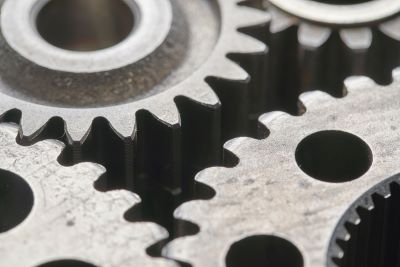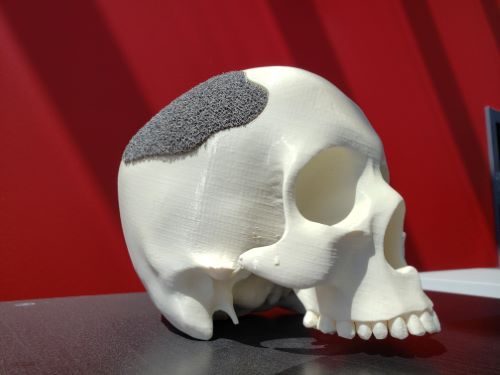A lot has happened since the Bronze Age. There are thousands of different types and grades of metal out there, and each one is developed for very specific applications.
Every day, you’ll regularly come into contact with dozens of kinds of metals. Here’s an interesting guide that will walk you through some of these common metals and where you’ll find them.
Table of Contents
Steel
This is hands down the most common metal in the modern world.
Steel, by definition, is simply iron (the element) mixed with carbon. This ratio is usually around 99% iron and 1% carbon, although that ratio can vary a bit.
Fun fact: There was over 1.8 billion tons of steel produced worldwide in 2017 (half of which was produced in China). An average African elephant weighs about 5 tons. If you were to stack elephants one on top of the other to form a really peculiar bridge to the moon (not actually possible), it would still not be as heavy as the weight of the steel that’s made each year.
There are actually a lot of different kinds of steel. Here’s an overview of the main types:
Carbon Steel
This is the basic steel, good ‘ol carbon and iron, although some other very small amounts of other elements might be added.
The three general categories are low, medium, and high carbon steel. More carbon means harder and stronger. Less carbon means cheaper, softer, and easier to produce.
Carbon steel is most commonly found as a structural building material, in simple mechanical components, and in various tools.
Alloy Steel
Think of it as genetically modified steel. Alloyed steel is made by adding other elements in the mix. This changes the properties and essentially makes the metal customizable. This is an extremely common type of metal because it’s generally still very cheap to make.
Common alloying elements for steel include manganese, vanadium, chromium, nickel, and tungsten. Each of these elements will modify the metal’s properties in different ways.

For example, alloying steel can give extra strength to high-performance gears, more corrosion and wear resistance to medical implants, and increase the amount of pressure that pipelines can handle. It’s generally considered the workhorse of the metal world.
Stainless Steel
Technically this is a kind of alloy steel, but there are so many types in such massive quantities that it usually gets its own category. This is the steel that is specifically focused on corrosion resistance.
This is basically just steel with a noticeable amount of chromium. The chromium creates a super thin barrier when it corrodes which slows rust. If you scratch off the barrier, a new one will immediately form.
You’ll see a lot of this in kitchens; knives, tables, utensils, anything that comes into contact with food.
Not-so-fun fact: Just because something is stainless steel, that doesn’t mean that it can’t rust. Different compositions will prevent rusting to various degrees. Stainless steel that’s used around salt water needs to be especially corrosion resistant so it doesn’t rot out. But all of the types of stainless will rust if not cleaned and properly cared for.
If you want to know more about stainless steels (and how to identify them) click here for my guide.
Iron (Wrought or Cast)
Even though this is a super old-fashioned metal (especially common during the “iron age”) it still has a lot of modern uses.
For one, it’s the primary ingredient in steel. But beyond that, here are a few other applications and an explanation of why iron is used:
- Cookware (like skillets) – The porous surface will allow cooking oils to burn in and create a natural non-stick surface
- Wood stoves – Cast iron has an extremely high melting point so the stove can handle high temperatures
- Heavy machinery bases and frames – this heavy metal reduces vibration and provides rigidity
Fun fact: Iron is the sixth most common element in the universe.
Aluminum
As far as metals go, this is a really modern one. Aluminum was first made in 1825, and since then it’s been the foundation for some massive accomplishments.
For example, because of its amazing strength-to-weight ratio, this is the metal that’s largely responsible for flight and getting man to the moon. It’s easily formed (malleable), and it doesn’t rust, which makes it great for soda cans. And, (arguably) most importantly, it can be made into a really thin sheet that can be used to BBQ fresh-caught fish to moist perfection.

While the process for making aluminum is a bit more complicated than some of the other metals, it’s actually an extremely common metal. It’s the most common non-ferrous (not containing iron) metal on the planet.
While it doesn’t rust, it will oxidize. Iron is actually the only metal that “rusts” by definition. Aluminum will corrode when it comes in contact with salt. However, it will not corrode in contact with water. This makes aluminum really useful for making things like freshwater boats.
You probably interact with aluminum on a daily basis more often than you think. This article will explain why.
Magnesium
Magnesium is a really cool metal. It’s about 2/3rds the weight of aluminum, and it has comparable strength. It’s becoming more and more common because of this.
Mostly commonly, you’ll see this as an alloy. That means that it’s mixed with other metals and elements to make a hybrid material with specific properties. This can also make it easier to use for manufacturing processes.
One of the most popular applications of magnesium is in the automotive industry. Magnesium is considered a step up from aluminum when it comes to high-strength weight reduction, and it’s not astronomically more expensive.
Some places where you’ll see magnesium on a performance car are in the wheel rims, engine blocks, and transmission cases.
There are disadvantages to magnesium, though. Compared to aluminum, it will corrode more easily. For example, it will corrode when in contact with water, where aluminum will not.
Overall it’s about double the price of aluminum, but it’s generally faster to deal with in manufacturing.
Fun fact: Magnesium is really flammable, and it burns super hot. Metal chips, filings, and powder need to be carefully disposed of to prevent explosions.
Copper
Copper is another old-fashioned metal. Today you’ll see it often as an alloy (more on that later) or in a reasonably pure state.
Common applications include electronics, water pipes, and giant statues that represent liberty. Copper will form a patina, or an oxidized layer, that will actually prevent further corrosion. Essentially, it’ll turn green and stop corroding. This can make it last for centuries.

If you want some more info on why this metal turns green, then you might find this article I wrote to be an interesting read.
Brass
Brass is actually an alloy of copper and zinc. The resulting yellow metal is really useful for a number of reasons.
Its goldish color makes it really popular for decorations. It’s common to see this metal used in antique furniture as handles and knobs.
It’s also extremely malleable, meaning that it can be hammered out and formed. This is why it’s what’s used for brass instruments like tubas, trumpets and trombones. They’re easy to hammer into shape (relatively speaking) and they’re durable.

Another really cool property of brass is that it will never spark. A steel hammer, for example, can make a spark if you hit it a certain way. A brass hammer doesn’t do that. This means that brass tools are great for areas that might be around flammable gases, liquids or powders.
Bronze
This is made primarily with copper, but it also contains around 12% tin. The result is a metal that’s harder and tougher than plain copper.
Bronze can be an alloy with other elements, too. For example, aluminum, nickel, zinc, and manganese are common alloying elements. Each of these can very noticeably change the metal.
Bronze has massive historical significance (like in the Bronze Age) and is easy to pick out. One common place to see it is in massive church bells. Bronze is tough and strong, so it doesn’t crack or bend like other metals when it’s being rung. It also sounds better.
Modern uses include sculptures and art, springs and bearings, as well as guitar strings.
Fun fact: Bronze was the first man-made alloy.
Zinc
This is an interesting metal because of how useful it is.
On its own, it has a pretty low melting point which makes it very easy to cast. The material flows easily when melted and the resulting pieces are relatively strong. It’s also very easy to melt it back down to recycle it.
Zinc is a really common metal that’s used in coatings to protect other metals. For example, it’s common to see galvanized steel, which is basically just steel dipped in zinc. This will help to prevent rusting.
Fun fact: About 12 million tons of zinc is produced annually, and half of that is used for galvanizing.
Titanium
This is a really amazing modern metal. It was first discovered in 1791, first created in its pure form in 1910, and first made outside of a laboratory in 1932.
Titanium is actually really common (the 7th most abundant metal on Earth), but it’s really hard to refine. This is why this metal is so expensive. It’s also really worthwhile:
- Titanium is biocompatible, meaning that your body won’t fight and reject it. Medical implants are commonly made from titanium.
- Its strength to weight ratio is higher than any other metal. This makes it extremely valuable for anything that flies.
- It’s really corrosion resistant
- Titanium nitride (titanium that’s reacted with nitrogen in a high energy vacuum) is an insanely hard and low-friction coating that’s applied to metal cutting tools.

Fun fact: The reason that titanium resists corrosion is because it instantly reacts with oxygen, creating a really thin, hard barrier that protects the metal. If you scrape off the barrier, a new one instantly forms. It’s kind of like it’s self-healing.
Bonus fun fact: Titanium isn’t found naturally on its own. It’s always bonded to another element.
Tungsten
Tungsten has the highest melting point and the highest tensile strength of any of the pure metals. This makes it extremely useful.
About half of all tungsten is used to make tungsten carbide. This is an insanely hard material that’s used for cutting tools (for mining and metalworking), abrasives, and heavy equipment. It can easily cut titanium and high-temperature superalloys.
It gets its name from the Swedish words “tung sten“, which mean “heavy stone”. It’s about 1.7 times the density of lead.
Tungsten is also a popular alloying element. Since its melting point is so high, it’s often alloyed with other elements to make things like rocket nozzles that have to be able to handle extreme temperatures.
Adamantium
This isn’t real.
Unfortunately.
Nickel
Nickel is a really common element that’s used all over. Its most common application is in making stainless steels, where it boosts the metal’s strength and corrosion resistance. Actually, almost 70% of the world’s nickel is used to make stainless steel.
Interestingly, nickel only makes up 25% of the composition of the five cent American coin.

Nickel is also a common metal to use for plating and alloying. It can be used to coat lab and chemistry equipment, as well as anything that needs to have a really smooth, polished surface.
Fun fact: Nickel gets its name from medieval-era German folklore. Nickel ore looks a lot like copper ore, but when the old miners couldn’t get copper from it they blamed a mischievous sprite named Nickel.
Cobalt
This is a metal that has been used for a long time to make blue pigment in paints and dyes. Today, it’s primarily used in making wear-resistant, high-strength steel alloys.
Cobalt is very rarely mined by itself, it’s actually a by-product of the production of copper and nickel.
Tin
Tin is really soft and malleable. It’s used as an alloying element to make things like bronze (1/8th tin and 7/8ths copper). It’s also the primary ingredient in pewter (85-99%).
Fun fact: When you bend a bar of tin, you can hear something called a “tin cry”. This is a twanging sound of the crystal structure reorganizing itself (called twinning).
Lead
Lead is really soft and malleable, and it’s also very dense and heavy. It’s got a really low melting point, too.
In the 1800s it was discovered that lead is actually pretty toxic stuff. That’s why it’s not so common in modern times, although it wasn’t all that long ago that it was still found in things like paints and bullets.
Lead is a neurotoxin that can cause brain damage and behavioral problems, among other things.
That said, it still does have modern uses. For example, it’s great for radiation shielding. It’s also occasionally added to copper alloys to make them easier to cut. The copper-lead mix is often used to improve the performance of bearings.
Silicon
Technically speaking, silicon is a metalloid. This means that it has both metallic and non-metallic qualities.
For example, it looks like a metal. It’s solid, shiny, bendable, and has a high melting point. However, it does a terrible job of conducting electricity. This is partly why it’s not considered a full metal.
Even still, it’s a common element to find in metals. Using it for alloying can change the metal’s properties quite a bit. For example, adding silicon to aluminum makes it easier to weld.
Random, Interesting, and Useless Information
What metal has the longest name?
According to the periodic table, praseodymium (pray·zee·ow·di·mee·uhm) has the longest name out of any element. It’s used mainly in alloys. For example, it’s used as an alloying element in magnesium for making aircraft engines. It’s also used in the flints for cigarette lighters and in permanent magnets.
How many types of metals are there?
94 of the 118 elements on the periodic table are listed as metals. In other words, about 80% of the elements that we know of are some kind of metal!

